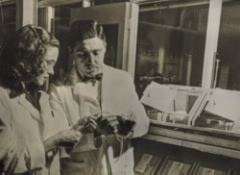Helen Free (1923-2021)
Helen M. Free and her husband, Alfred Free (1913–2000), developed a revolutionary testing method for diabetes and other disease that today gives patients an inexpensive way to help manage illness. The invention, a chemically coated dip-and-read stick, measures key indicators of disease by changing color when dipped in a urine sample.
Helen did not immediately select the chemistry field as a student. When she entered the College of Wooster in 1941, she wanted to become an English and Latin teacher. With a decline in male students, who were drafted for World War II, women on campus were advised to occupy the empty seats of the male-dominated discipline. Helen took heed, enjoying her chemistry courses enough to change her major.
When she completed her degree in 1944, Free was offered a position testing the quality of vitamin ingredients in the control lab of Miles Laboratories (now part of Bayer) in Elkhart, Indiana, known for its main consumer product, Alka-Seltzer. But her true interest was in biochemistry. When a position with biochemist Alfred Free opened up, Helen jumped at the opportunity to work with his group. Two years later, she married Alfred, and the two became lifelong research partners.

One of the team’s first projects was to further develop Clinitest®, a tablet for testing glucose levels in the urine of diabetes patients. The group needed to make the test more sensitive. Clinitest® contained cupric sulfate, citric acid, sodium hydroxide and carbonate to make it fizz. The amount of glucose was determined from the color change when the tablet was placed in a small test tube with a dilute urine solution. It was the first diagnostic test that could be done in a doctor’s office or a hospital without elaborate laboratory facilities.
The test was also simple enough for patients to monitor their levels from home. Other tests developed by the group were the tablet Acetest (for diabetics) and Ictotest®, used for diagnosing Hepatitis A. Ictotest® was the inspiration for creating an even more convenient diagnostic test using a urine test strip. In 1956, Clinistix®, the widely used dip-and-read test for glucose in urine, was born! The invention was named a National Historic Chemical Landmark by the ACS in May 2010.
The Free research group was successful in developing other strips that detect key indicators of disease, and later was able to combine more than one test on a single strip. By 1981, the group developed the revolutionary Multistix®, a single strip for urinalysis of 10 different clinical tests.
Helen and Alfred Free retired in 1982, though Helen served as a consultant to what is now Bayer Diagnostics until 2007. Helen became a champion for science education and outreach, chairing the National Chemistry Week task force of the ACS for five years. She received the ACS’s Garvan Medal, honoring distinguished service to chemistry by a woman, in 1980.
In 1993, she became the third of only seven women elected president of ACS. As president, Free’s top priority was to raise public awareness of the positive role chemistry has played in our lives. ACS instituted an award in her honor in 1995: the Helen M. Free Award in Public Outreach.
She and her husband hold several patents and coauthored two books on urinalysis. Both scientists were inducted into the National Inventors Hall of Fame in 2000 and the Science and Engineering Hall of Fame. In 2010, Free received the National Medal of Technology and Innovation, the highest honor bestowed by the United States government on scientists, engineers, and inventors.
Sources
- Retired Bayer Chemist Helen M. Free Honored. (n.d.). Regional and Country News: Our Strengths. Retrieved from http://www.mybayerjob.com/en/regionalandcountrynews/America/Bayer_chemist_honored/index.html.
- Helen M. Free and Alfred Free. (n.d.). Chemistry in History. Retrieved from http://www.chemheritage.org/discover/chemistry-in-history/themes/pharmaceuticals/diagnosing-diseases/free-and-free.aspx.
- Helen M. Free dies at age 98 Retrieved from Chemical and Engineering News (May 6, 2021)
National Landmark: Development of Diagnostic Test Strips

On May 1, 2010, the American Chemical Society dedicated the development of test strips, a measurement tool created by Helen and Alfred Free that tracks the presence of glucose and other substances in urine and blood. Today, self-management of metabolic diseases and kidney and liver conditions is an easier process as a result of the couple’s research.
ACS Women Presidents
In its 135-year history, seven women have been elected president of the American Chemical Society. Helen Free was the third!
- Anna J. Harrison (1978)
- Mary L. Good (1987)
- Helen Free (1993)
- Elsa Reichmanis (2003)
- E. Ann Nalley (2006)
- Katie Hunt (2007)
- Nancy Jackson (2011)
- Marinda P. Li Wu (2013)
- Diane Grob Schmidt (2015)
- Donna J. Nelson (2016)
- Allison A. Campbell (2017)

